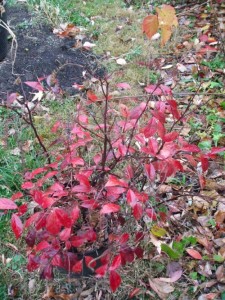
Summer Wine ninebark's purple foliage turns a brilliant red in fall. Its companion is 'Limelight' hydrangea. (C) Jo Ellen Meyers Sharp
This long season of mellow weather has enhanced the fall color on many trees and shrubs and prolonged their beauty.
‘Blue Mist’ fothergilla (F. gardenii), one of the first shrubs I bought when I moved here, earned its keep this fall despite lackluster performance in the past. This native shrub promised reddish-orange leaves in fall. Unfortunately, the reddish-orange did not really materialize until this year, when the color has been as promised.
Many viburnums have great fall color, but the Burkwood (V. x burkwoodii) usually is semi-evergreen, holding onto its green leaves well into winter or early spring. In my yard, one gets several hours of direct sun and one gets dappled sun. The one in sun turned a brilliant red orange this fall and recently dropped all its leaves, which it has not done in the past. The one in more shade has retained its green leaves for now.
There are a couple of popular Virginia sweetspires (Itea virginica) on the market, ‘Henry’s Garnet’ and ‘Sprich,’ which is sold as Little Henry. Each of these native shrubs has beautiful red fall color. However, ‘Henry’s Garnet’ retains its fall color much longer than Little Henry. These versatile plants are terrific substitutes for the burning bush (Euonymus alata), which is considered an invasive species.
At the top of the list for spectacular fall color has to be the oakleaf hydrangeas (H. quercifolia), another native shrubs. Oakleaf hydrangeas bloom white cone-shaped flowers in early summer, which stay on the plant into winter, turning reddish brown to tan as they age. The foliage turns a beautiful reddish purple, a color it holds for weeks, usually well into winter.
Lastly, another prizewinner is ‘Seward,’ a native ninebark (Physocarpus opulifolius), which is marketed as Summer Wine. Its bronzy purple leaves turn a deep red and persist for weeks.
